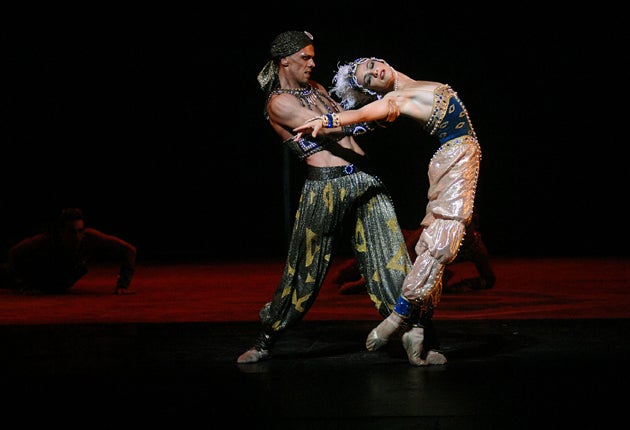Ballets Russes, English National Ballet, Sadler's Wells, London

Your support helps us to tell the story
From reproductive rights to climate change to Big Tech, The Independent is on the ground when the story is developing. Whether it's investigating the financials of Elon Musk's pro-Trump PAC or producing our latest documentary, 'The A Word', which shines a light on the American women fighting for reproductive rights, we know how important it is to parse out the facts from the messaging.
At such a critical moment in US history, we need reporters on the ground. Your donation allows us to keep sending journalists to speak to both sides of the story.
The Independent is trusted by Americans across the entire political spectrum. And unlike many other quality news outlets, we choose not to lock Americans out of our reporting and analysis with paywalls. We believe quality journalism should be available to everyone, paid for by those who can afford it.
Your support makes all the difference.Between 1909 and 1929, Diaghilev's Ballets Russes was a powerhouse: a company at the forefront of dance, music and design.
English National Ballet's centenary celebration tries to catch that range. Besides revivals of major works, ENB looks to Diaghilev's sense of innovation and fashion by including new work, designs by Chanel's Karl Lagerfeld, and a sprinkling of celebrities on opening night. It's a very mixed result.
On paper, it's a bright idea to ask Lagerfeld to design a new tutu for "The Dying Swan". Chanel herself designed for Diaghilev; this is a new link to the past. But Lagerfeld's tutu is an unflattering disaster, taking every opportunity to spoil its ballerina's line. Elena Glurdjidze's ruffled bodice blurs and thickens her waist, while the feather ruff completely hides her neck.
"The Dying Swan" has other problems; some of the most famous Ballets Russes repertory revives badly. In 1911, Nijinsky was a sensuous sensation in Le Spectre de la Rose. Nowadays, the ballet looks like a party piece with a big jump through a window. Daniel Gaudiello jumps with an odd twist, pulling himself higher in the air, but the perfume has gone.
ENB takes on another celebrated Nijinsky role by reworking it. David Dawson's new Faun(e) takes Debussy's L'Après-midi d'un Faune and sets it for two male soloists. It's a glossy, swoopy number: Raphaël Coumes-Marquet dances alone, leaning into the choreography, with its circled shoulders and backbends, before passing it on to Esteban Berlanga. It is beautifully articulated, but it doesn't go anywhere.
Schéhérazade is even odder, a 1910 Arabian Nights fantasy that manages to be silly, dated but still sumptuous. Fokine's theme is a fruity harem number, the women holding an orgy with slaves. There are embarrassing eunuchs, dances with trays of fake fruit, wild jumps and daft writhings.
The evening opens with its strongest work as ENB dance Balanchine's Apollo with confidence. Thomas Edur is an elegant Apollo, every step smooth and musically aware, with Agnes Oaks alert as Terpsichore. At first, this cast dance politely, timing their steps behind the beat. In the final numbers, they wake up to a sharper, jazzier response, on top of the beat and all the better for it.
Further performance at St Paul's Cathedral on 30 June (www.ballet.org.uk)
Join our commenting forum
Join thought-provoking conversations, follow other Independent readers and see their replies
Comments